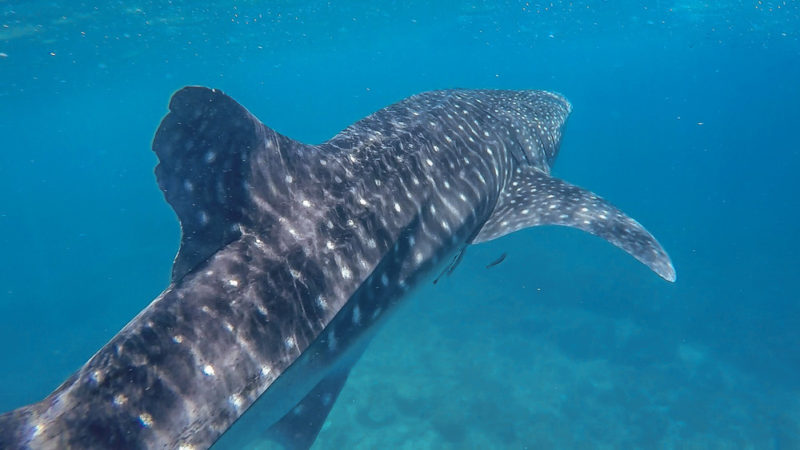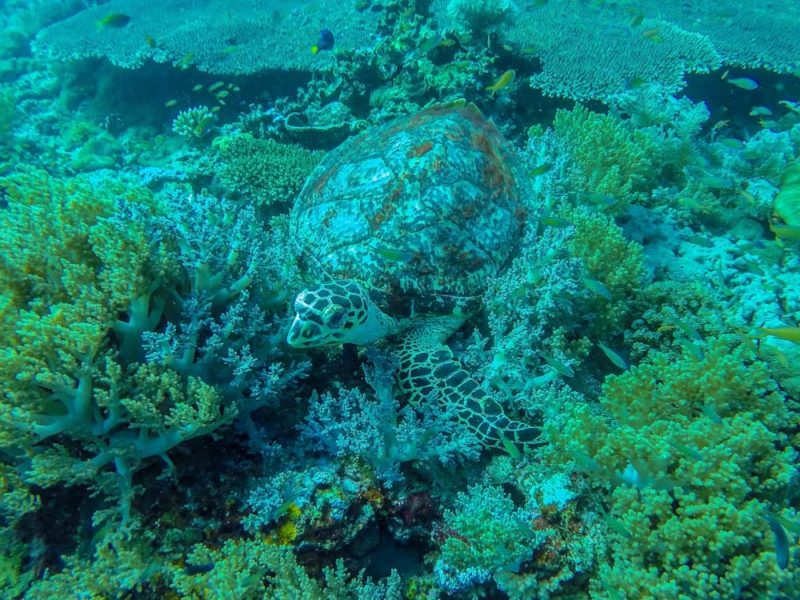Whale sharks are one of the most incredible animals on this planet. Getting close to one of these amazing creatures is a once-in-a-lifetime experience. Being dwarfed in the presence of a creature so large is astounding. It is possible to swim with whale sharks ethically in the Philippines with a bit of determination.
Seeing these gentle giants was on my bucket list for a long time. I first saw whale sharks while backpacking in Mozambique. Timon, however, had never seen a whale shark and was excited about getting a chance to swim with them in the Philippines.
We had seen all these amazing shots on Instagram – people swimming inches away from these magical beasts and drone shots from above with seven whale sharks circling a tiny fishing boat.
We were anxious to have the same experience, but we wanted to make sure we did it the ethical way. Many tour operators in the Philippines don’t, so if you’re looking for the best way to swim with whale sharks, read on to learn how!
Content and photographs provided by Yana Kogan and Timon.
Disclaimer: This post may contain affiliate links. If you make a purchase or booking through one of our links we may earn a small commission (don’t worry, it’s at no extra cost to you).
How to Swim with Whale Sharks in the Philippines
Why You Shouldn’t Swim with Whale Sharks in Oslob
There are many options around the world to see whale sharks: Mozambique, Mexico, Maldives, Australia, and the Philippines. When visiting the Philippines, many tourists flock to the town of Oslob in Cebu. The local fishermen found out about 10 years ago that by feeding the whale sharks they could move them so they wouldn’t interfere with fishing.
Tourists got wind that whale sharks were easy to spot in this particular town. After a few years of word of mouth and pictures disseminating on the internet, hundreds flock daily to Oslob for a near-guaranteed chance to see a close-up encounter with a whale shark.
Every day the local boatmen feed the whale sharks so they come up to the surface while tourists swim next to them. Dozens of people surround one whale shark to get that perfect selfie. Obviously feeding wildlife is always a no-no, no matter where you are.
What it is Really Like in Oslob

The area where the interaction occurs is about the size of a soccer field. There are hundreds of tourists being ushered back and forth to swim with the whale sharks each day. Usually, there are anywhere between three to eights whale sharks and dozens of people in this small area at any given time. With that many people, it’s hard to keep track of what’s going on.
Although touching them is forbidden, with so many tourists and such little space there is bound to have some interaction. Just take a look at all the photos on social media, and you’ll see people touching their skin and fins.
How Does Feeding Affect Whale Sharks
It is unclear how feeding whale sharks will affect them in the long run, but so far there has been a noticeable change in their migratory patterns. Although this may not seem like a huge issue, there is so much that is unknown about whale sharks. This could potentially be detrimental to their survival.
In addition, the whale sharks are more willing to come closer to boats, which has caused them to be injured. There is still a market for whale shark meat and fins, and because they see boats as a food source, they are more likely to get poached.
Also, they are being fed only one type of food and are not getting the variety of nutrients their body needs. Because of their long lifespan, it is unclear how feeding them will affect the species and the sustainability of this practice. Whale sharks are currently listed as an endangered species by the IUCN. So, why risk endangering them any further?
Is it Worth the Photo?

I understand wanting to get a good photo, but the practice of feeding these enormous creatures is not responsible tourism and it is not a sustainable practice.
You, of course, are free to do what you want. Ride elephants, go to unethical animal “sanctuaries”, pet drugged-up tigers, and take selfies with whale sharks in Oslob. But, as a tourist, where you spend your money affects generations to come.
Should You Go to Oslob to swim with Whale Sharks?

Am I saying for everyone to stop going to Oslob? No, that would be detrimental to the people and economy of Oslob. But, there needs to be more education regarding ethical practices for swimming with whale sharks and a solution needs to be in place to make this a more sustainable tourism attraction.
Some options to make swimming with whale sharks more eco-friendly include slowing or stopping the feeding of the sharks. There should be a cap on the number of people that can visit the site daily and the regulations need to be strictly enforced.
A higher price tag to swim with the sharks would limit the number of experts. I’m no expert, but these are easy changes to help Oslob become a more sustainable tourist site.
There are ethical ways to see these magnificent animals while supporting whale shark ecotourism in the Philippines. For more information, check out this National Geographic Article.
Where to Ethically Swim with Whale Sharks in the Philippines

There are two places for ethical whale shark encounters in the Philippines. When I arrived, I knew I wouldn’t go to Oslob because of their unsustainable practices. But I heard of a couple of places where you could spot a whale shark ethically and responsibly – Donsol, Luzon, and Sogod Bay, Southern Leyte.
Because of the season and location, we decided to go to Sogod Bay in Southern Leyte.
Sogod Bay, Southern Leyte
Even though is not guaranteed, the chance of seeing a whale shark in Sogod Bay is extremely promising. Due to the ethical practices of local fishermen, eco-friendly education of the tour outfitters by a local NGO Lamave, and strict sustainable regulations, whale sharks flourish here.
And because it is more remote and less known, there are usually only a handful of people visiting each day! This may not be one of the easiest places to go to, but who said it was going to be easy?
Ethical Guidelines for Whale Shark Encounters
Sogod Bay, Southern Leyte abides by some very strict regulations for their business. Scuba diving is not allowed with whale sharks. No feeding and no touching is permitted, and with small groups, this is strictly enforced.
At the first sighting, you have three hours to spend with and/or look for whale sharks. After that, the boat returns to land. Even if you see one for 10 minutes, then nothing for the rest of the three hours, your experience is over.
However, this is unlikely. Between the months of November and May, many adolescent whale sharks are easy to spot in the area and the juvenile males are extremely curious. On our trip, we swam with one for 45 minutes. It was incredible. He was so curious and kept looking at us and swam back and forth slowly.
In our three hours, we saw four different whale sharks. Let me tell you, seeing them swim by you is an out-of-this-world experience.
Sogod Bay Eco-Friendly Whale Shark Interaction

From Padre Burgos, it is a long boat ride to the inlet where the whale sharks are known to hang out and eat. It takes around two hours. Once you arrive at the small inlet within Sogod Bay, the boat arranges local spotters from the nearby village.
Depending on the company, they typically hire between four to eight spotters. The spotters then use very tiny wooden canoes and paddle around the bay with a mask, looking for the whale sharks. Once they spot one, they raise their paddle to tell the boat where they are.
The boat moves to where the whale shark is heading. People jump in the water with instructions from the guide. They may be gracefully swimming by, or deeper underwater and moving very fast. If you get tired, you can hop onto the tiny canoes and the spotter can paddle closer to the front of the whale shark.
Overall, we were very impressed with the interaction and how hard the spotters were working to make it an incredible experience for us.
It helps to create local jobs by involving local fishermen. Local families benefit from the eco-friendly whale shark tours and follow local guidelines to ensure they maintain a steady business for future generations.
Information on Sogod Bay
How to Get to Eco-Tourism Sites in Sogod Bay: Most eco-tours leave from the town of Padre Burgos. It is not the easiest to get to, but it’s worth it. Getting to this tiny village will require overland transportation. If not on a very strict budget, you can hire private transport from the ferry terminal or airport. Public transport on the island will take a long time and requires several transfers.
From Manila: The closest airport is in Tacloban. From here it is a 3.5-hour overland trip to Padre Burgos. It is best to pre-arrange transport with your accommodation.
From Cebu: There are three or four ferry companies that go from Cebu City to Leyte. They will either arrive in Maasin or Hilongos. Hilongos is a two-hour transport, and Maasin is thirty minutes from Padre Burgos.
From Bohol: There is a ferry from Ubay that arrives in Bato. It is one and a half hours from Bato to Padre Burgos.
Best Time to Visit Southern Leyte: The whale shark season is between November and May.
Eco-Friendly Whale Sharks Tours: There are more popping up each year, but we suggest going with Padre Burgos Castle Resort, Peter’s Dive Resort, or our choice: Sogod Bay Scuba Resort.
Scuba Diving in Padre Burgos: This is an amazing scuba diving destination. It’s not as well known as other locations in the Philippines, but it is becoming more popular each year. The reefs are in amazing condition and divers in the know say this is one of the best places in the Philippines to dive. Some of the best dive sites include Napantao and Limasawa Island (Zach’s Cove and Adrian’s Cove).
Things to Know: There are no ATMs, so bring all your cash with you.
Donsol, Luzon
We didn’t go to Donsol for our whale shark experience, but we gathered some info (below).
Donsol Eco-Friendly Whale Shark Interaction
While we did not go to Donsol, we have heard from others who have been and we’ve done extensive research. Donsol originally was on par with Sogod Bay – encounters were high and guidelines were stringent.
However, we are hearing different stories today. More often than not, people may have only one encounter during three days of searching for whale sharks. Water visibility is also not known to be as clear as Sogod Bay. In addition to all that, Donsol is more popular than Sogod Bay, which can attract a dozen boats searching for whale sharks.
With all that said, they still do NOT feed the whale sharks. It also is a much more affordable experience than Sogod Bay. We highly recommend Donsol over going to Oslob, which will be a more authentic and eco-friendly experience.
Information on Donsol

How to Get to Eco-Tourism Sites in Donsol: From Cebu or Manila, fly to Legaspi Airport, take a public van or private van to Donsol – about a 1-hour 30-minute drive. You can take a bus from Manila to Donsol, which takes 11 hours.
Best Time to Visit Donsol: The whale shark season is between November and May.
Eco-Friendly Whale Sharks Tours: Whale Shark Interaction Center.
Cost for Diving With Whale Sharks: Registration is 150 PHP per person, and snorkel gear hire is 300 PHP per set. Tour packages cost 3,500 PHP for the entire boat (up to 7 people). This includes half-day boat rental, snorkel gear, spotters, a guide, and a Butanding (whale shark) interaction officer.
Sustainable & Eco-Friendly Guidelines for Swimming with Whale Sharks:
- Do not block the shark’s path or restrict its movement
- Do not chase the whale shark
- Do not touch or ride the whale shark
- Keep a responsible distance of three meters (nine feet) away from the tail
- Do not use flash photography
- Keep noise to a minimum when getting in the water
Whale Shark Facts

- Whale sharks live to be around 80 years old
- They are filter feeders and their diet consists mostly of plankton, krill, and fish eggs
- They are migratory creatures that can weigh up to 50,000 pounds (19,000 kg)
- The largest recorded whale shark was 41 feet long (12 meters), but they are commonly between 15 and 23 feet (5-8 meters) long
- There is very little knowledge about their reproductive system
- Whale sharks have about 3,000 tiny teeth
- Whale sharks move at about 2.3 miles per hour
- Adult whale sharks have no natural predators
- Females are larger than male whale sharks
That’s it – we hope you enjoy Your swim with whale sharks in the beautiful country of the Philippines!
SHARE THIS ON PINTEREST









Hello! Thanks for this information. Me and my German husband to be plan to have a wedding in Palawan in February, and he mentioned he wanted to swim with whale sharks. I’m Filipina so I want to make this as my gift for him. I do understand and agree about ethical practices with our wildlife and plan to follow your advice. This was very good to know before ending up in Oslob. I guess we will be going to Leyte. Many blessings to you!